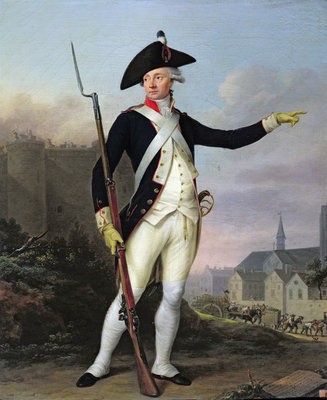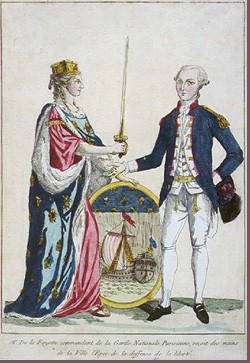
The National Guard (French, Garde nationale) was a citizens’ militia formed in Paris the day before the assault on the Bastille. Those who created the National Guard intended it to protect Paris from counter-revolutionary attacks and internal stability. As the revolution unfolded, however, the National Guard, which was dominated by affluent bourgeois interests, would come into conflict with the working classes of Paris more than any external threat.
Background
By the summer of 1789, the National Assembly was ensconced at Versailles, Paris was in a state of agitation bordering on open rebellion and the French king, Louis XVI, was uncertain what to do.
In the first week of July, royal troops began massing at several critical points near Paris and Versailles. Parisians began to fear a royalist counter-revolution and the imposition of martial law. The city fell into panic and disorder; petty crime and acts of violence began to increase. The sacking of popular minister Jacques Necker on July 11th exacerbated these fears and Paris slipped into a state of insurrection.
Leading figures of the Paris bourgeoisie decided to act. On July 13th, a group of Parisian delegates to the National Assembly met in the Hôtel de Ville, the riverside building housing the municipal government. Concerned the capital was at risk from an invasion by the king’s soldiers, as well as rioting and looting by its own citizens, the delegates voted to form a citizens’ militia. They asked the king to endorse this move – he declined but they resolved to form it anyway. The militia they created became known as the National Guard.
Formation
At first, the new body was conceived as a ‘city guard’ tasked with protecting Paris from external threats and maintaining order in the capital. It was to be an instrument of its organising committee, independent of the army, beyond the control of the king and, most importantly, loyal to the National Assembly and the bourgeois revolution.
Planners expected the National Guard, when fully complemented, would number around 48,000 men. It would be led by a commander-in-chief, who would be stationed at the Hotel de Ville alongside the municipal government. The Guard would employ the city’s blue and red flag as a standard; its soldiers would wear cockades of the same colours.
The formation of the National Guard was met with popular support and enthusiasm. There was a surge of volunteers eager to join this new Parisian brigade. Many came from the ranks of the French Guard, the royal battalion garrisoned in Paris. Caught up in the fervour of the revolution, many of these soldiers volunteered their services to new corps.
Within a few hours, militia groups formed haphazardly across Paris and declared their loyalty to the National Guard. They adopted suitably coloured clothing and cockades, where they could, and some marched on the Hôtel de Ville to await instructions. Arms were still in short supply so very few of these groups carried guns. They were not sufficiently organised to have any impact on events at the Bastille on July 14th, though some volunteers undoubtedly participated in the siege on the royal fortress.
Lafayette appointed commander

On July 15th, the day after the Bastille was stormed, the committee appointed the Marquis de Lafayette as commander-in-chief of the recently formed National Guard.
Lafayette’s appointment reflected both their politics and their hopes for the National Guard. The new commander was a nobleman, a liberal and a military veteran of the American Revolution. The committee saw in Lafayette a French George Washington, a political moderate who could maintain order in Paris yet still appeal to both the nobility and the Third Estate.
One of Lafayette’s first directives was to add white, the colour of the Bourbon monarchy, to the red and blue cockade of the National Guard. Thus was born the famous red, white and blue tricolore of the revolution. Lafayette’s high profile, his leadership of the National Guard, his support for the revolution and his attempts to reconcile the monarchy, aristocracy and common people would enhance his popularity, at least for a time.
“The National Guard was, in essence, a civilian institution endowed with military capabilities. The Parisian electors debated the name to be given to it. The word ‘militia’ was laden with unpleasant memories, so the term ‘guard’ was preferable, to be further defined with the adjective ‘bourgeois’ or ‘citizen’ following the traditional usage. This citizen militia was directed as much against the threat of the so-called dangerous classes, the turbulent mass of day-labourers and paupers, as against mercenaries in the king’s army. It was recruited from those with a steady job, a bit of property to protect and a stake in society.”
Albert Soboul, historian
Who joined the National Guard?
By the end of 1789, Lafayette had around 6,000 full-time National Guardsmen under his command. The composition of the National Guard reflected its origins as a bourgeois militia. Many recruits were former members of the French Guard who had defected after the fall of the Bastille. The remainder of the French Guard was absorbed into the National Guard in October 1789.
The officers of the National Guard were elected rather than appointed. Most officers were property owners or the sons of affluent bourgeoisie. While there were some political idealists in their ranks, most officers of the National Guard were more concerned about maintaining order and protecting private property than defending the revolution.
In October 1791, the National Constituent Assembly reinforced the middle-class composition of the National Guard by ordering that its ranks only be filled by tax-paying ‘active citizens’.
Conflict with the people

As a predominately bourgeois institution, the National Guard soon came into conflict with the radical goals and provocative methods of ordinary Parisians. Scanning the timeline of the revolution reveals examples of this conflict.
In his two years as commander, Lafayette often had to walk a fine line between loyalty to the Ancien Régime, the values of the revolution and the people of Paris. Lafayette’s good judgement, coupled with a degree of showmanship, helped defuse the October march on Versailles, preventing violence against the royal family and escorting them back to Paris.
In the months that followed Lafayette and the National Guard faced even greater challenges. On February 28th 1791 (the ‘Day of Daggers’) Lafayette and his men encountered a threatening standoff between 400 armed aristocrats, who had gathered at the Tuileries to protect the king, and an angry mob of Parisians. Lafayette’s actions probably prevented a massacre.
Frustrated by the worsening situation in Paris, Lafayette attempted to resign his commission. Though he was persuaded to stay, Lafayette found himself in an impossible situation, responsible for security in a city that was fast sliding into anarchy and virtual civil war.

1. The National Guard was an organised militia, intended to defend Paris from external military threats while functioning as a local garrison and maintaining order in the city.
2. It was officially formed on July 13th 1789 by Parisian delegates to the National Assembly, who were concerned about the presence of royalist troops outside Paris and growing disorder in the city.
3. The first commander of the National Guard was the Marquis de Lafayette, a nobleman and political liberal, famous for his military leadership in the American Revolution.
4. Under Lafayette’s command, the National Guard became a noticeably bourgeois institution, its officer corps filled with middle-class businessmen and property owners.
5. The growing radicalism of the revolution in 1791 pushed Lafayette and the National Guard into difficult situations, such as the ‘Day of Daggers’ and the Champ de Mars massacre.
Citation information
Title: ‘The National Guard’‘
Authors: Jennifer Llewellyn, Steve Thompson
Publisher: Alpha History
URL: https://alphahistory.com/frenchrevolution/national-guard/
Date published: October 12, 2019
Date updated: November 9, 2023
Date accessed: July 27, 2024
Copyright: The content on this page is © Alpha History. It may not be republished without our express permission. For more information on usage, please refer to our Terms of Use.
